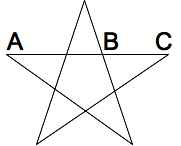Excerpted from A Dictionary of Fabulous Beasts, by Richard Barber and Anne Riches and Numbers, by David Wells.
Number: 1.61803 39887 49894 84820 45868 34365 63811 77203 09179 80576…
The Divine Proportion
The Divine Proportion or the Golden Ratio, equal to (sqrt(5)+1)/2.
In the pentagram, which the Pythagoreans regarded as a symbol of health, the ratio of AB to BC is the Golden Ratio.
Euclid in his Elements calls this division ‘in the extreme and mean ratio’ and used it to construct first a regular pentagon, then the two most complex Platonic solids, the dodecahedron, which has 12 pentagonal faces, and the icosahedron, which is its dual. The mystical significance of these beautiful polyhedra to the Greeks was naturally transferred to the Golden Ratio.
If a rectangle is drawn whose sides are in the Golden Ratio, it may be divided into a square and another, similar, rectangle. This process may be repeated ad infinitum. It is possible to draw an equiangular spiral through successive vertices of the sequence of rectangles.
The Golden Ratio, Φ, itself is intimately related to the Fibonacci sequence. Like Φ², the higher powers of Φ can all be expressed very simply in terms of Φ. Each power is the sum of the 2 previous powers, and the coefficiencts form the Fibonacci sequence over again, as do the integer parts of the powers.
(The Golden Ratio is often found in nature, in the spiral structure of sea shells and in the branches of plants and trees. See this Wikipedia article for more information.)
Beast: Anaye
The Anaye or Alien Gods of Navaho Indian myth are giants and monsters born of women without intervention of men. They include Thelgeth, who was headless and hairy, Tsanahale, harpy-like with feathered back, the Binaye Ahani, twins without legs or arms who slew with their eyes, and a nameless monster whose hair grew into the rock so that it could not fall from the cliff where it lived, and which preyed on travellers. They were all slain by the son of the water and the son of the sun, except for Old Age, Cold, Poverty, and Famine; these were allowed to live on, lest men should cease to honour the gods who protected them against these woes.